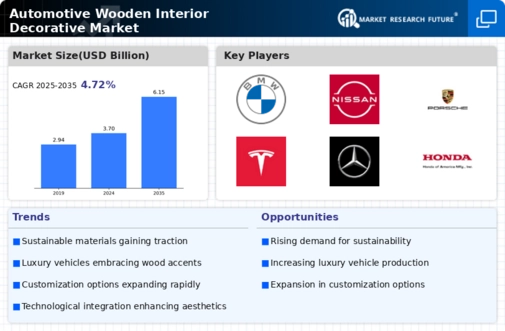Market Growth Projections
The Global Automotive Wooden Interior Decorative Market Industry is poised for substantial growth, with projections indicating a rise from 3.7 USD Billion in 2024 to 6.15 USD Billion by 2035. This growth trajectory suggests a compound annual growth rate of 4.72% from 2025 to 2035, reflecting the increasing integration of wooden elements in automotive design. Factors contributing to this growth include rising consumer demand for luxury interiors, sustainability initiatives, and advancements in manufacturing technologies. As the market evolves, it is likely to attract new players and innovations, further enhancing its dynamics.
Sustainability and Eco-Friendly Materials
Sustainability has emerged as a pivotal driver within the Global Automotive Wooden Interior Decorative Market Industry. Manufacturers are increasingly adopting eco-friendly materials, including responsibly sourced wood, to meet consumer expectations for environmentally conscious products. This shift not only aligns with global sustainability goals but also enhances brand reputation. Companies that prioritize sustainable practices are likely to attract a broader customer base. The market's growth trajectory suggests that by 2035, it could reach 6.15 USD Billion, indicating a robust demand for sustainable automotive interiors.
Technological Advancements in Manufacturing
Technological innovations are significantly influencing the Global Automotive Wooden Interior Decorative Market Industry. Advanced manufacturing techniques, such as precision cutting and laser engraving, enable the creation of intricate wooden designs that enhance the overall aesthetic of vehicle interiors. These technologies not only improve production efficiency but also allow for greater customization options, catering to diverse consumer tastes. As manufacturers leverage these advancements, the market is expected to witness a compound annual growth rate of 4.72% from 2025 to 2035, underscoring the potential for growth driven by technological integration.
Regulatory Support for Sustainable Practices
Regulatory frameworks promoting sustainable practices are playing a crucial role in shaping the Global Automotive Wooden Interior Decorative Market Industry. Governments worldwide are implementing policies that encourage the use of renewable materials and environmentally friendly manufacturing processes. This regulatory support not only fosters innovation but also incentivizes manufacturers to adopt sustainable practices. As a result, the market is likely to benefit from increased investment in eco-friendly technologies and materials, further driving growth and aligning with global sustainability initiatives.
Rising Consumer Preference for Luxury Interiors
The Global Automotive Wooden Interior Decorative Market Industry is experiencing a notable shift as consumers increasingly favor luxury and premium vehicle interiors. This trend is driven by a growing desire for aesthetics and comfort, leading manufacturers to incorporate wooden elements into their designs. For instance, high-end brands are utilizing sustainable wood materials to enhance the visual appeal of their vehicles. As a result, the market is projected to reach 3.7 USD Billion in 2024, reflecting the rising demand for luxurious interiors that resonate with consumer preferences.
Growing Demand for Customization and Personalization
The demand for customization and personalization in vehicle interiors is a significant driver of the Global Automotive Wooden Interior Decorative Market Industry. Consumers are increasingly seeking unique designs that reflect their individual preferences, prompting manufacturers to offer a wider range of wooden interior options. This trend is particularly evident in luxury segments, where bespoke interiors are becoming a hallmark of premium vehicles. As manufacturers respond to this demand, the market is poised for growth, with projections indicating a potential increase in value as consumer preferences evolve.



























Leave a Comment